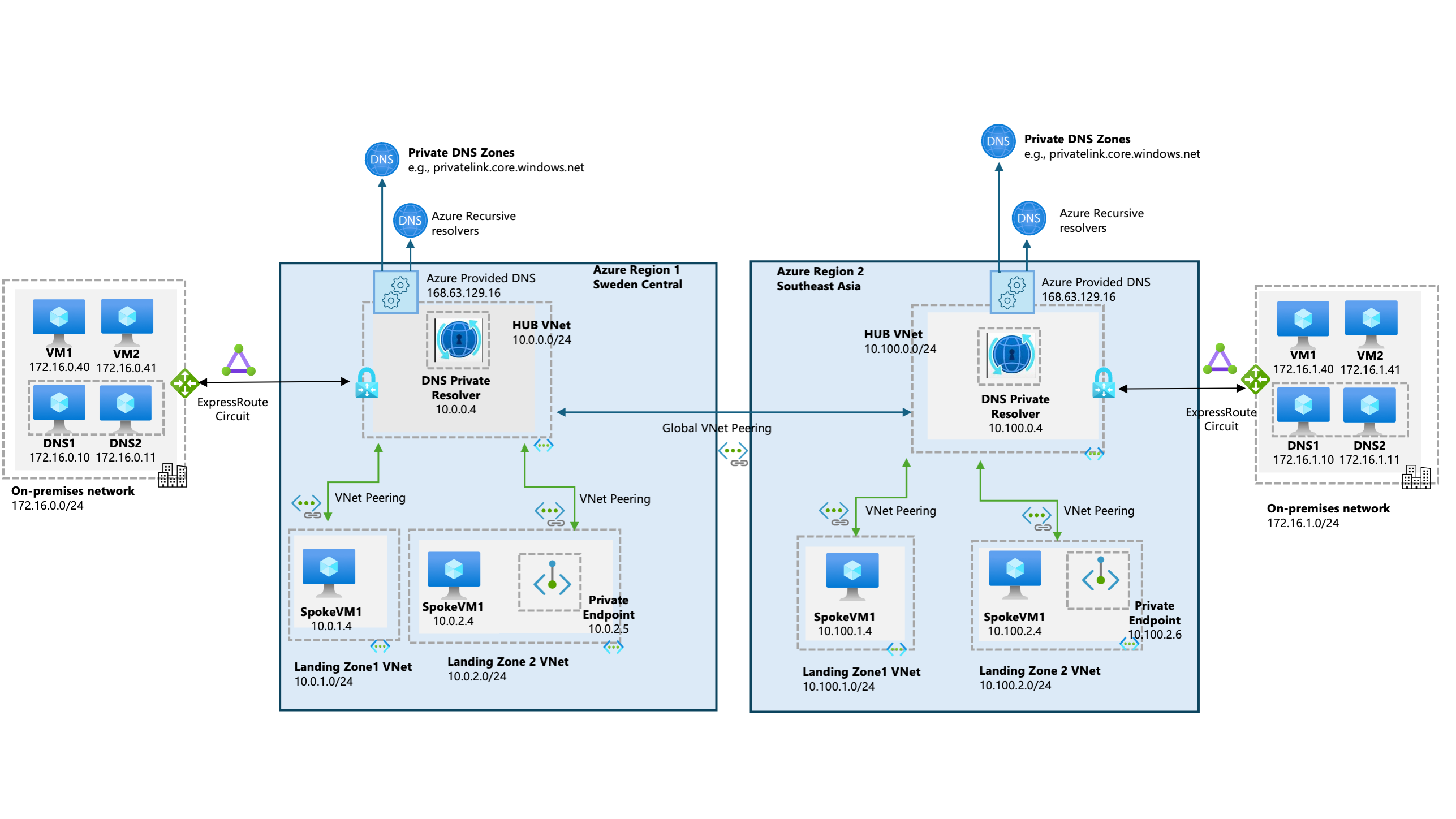Private Link and DNS integration at scale
This article describes how to integrate Azure Private Link for PaaS services with Azure Private DNS zones in hub and spoke network architectures.
Introduction
Many customers build their network infrastructure in Azure using the hub and spoke network architecture, where:
- Networking shared services (such as network virtual appliances, ExpressRoute/VPN gateways, or DNS servers) deploy in the hub virtual network (VNet).
- Spoke VNets consume the shared services by way of VNet peering.
In hub and spoke network architectures, application owners are typically provided with an Azure subscription, which includes a VNet (a spoke) connected to the hub VNet. In this architecture, they can deploy their virtual machines and have private connectivity to other VNets or to on-premises networks by way of ExpressRoute or VPN.
A central network virtual appliance (NVA), such as Azure Firewall, provides Internet-outbound connectivity. Additionally, that device, such as with Azure Firewall DNS proxy, or another service in or adjacent to the hub is typically used to customize DNS forwarding.
Many application teams build their solutions using a combination of Azure IaaS and PaaS resources. Some Azure PaaS services (such as SQL Managed Instance) can be deployed in customer VNets. As a result, traffic stays private within the Azure network and is fully routable from on-premises.
But some Azure PaaS services (such as Azure Storage or Azure Cosmos DB) can't be deployed in a customer's VNets and are accessible over their public endpoint. In some cases, this configuration causes a contention with a customer's security policies. Corporate traffic might not allow the deployment or accessing of corporate resources (such as a SQL database) over public endpoints.
Azure Private Link supports access to a list of Azure services over private endpoints, but it requires that you register those private endpoint records in a corresponding private DNS zone.
This article describes how application teams can deploy Azure PaaS services in their subscriptions that are only accessible over private endpoints.
This article also describes how application teams can ensure that services automatically integrate with private DNS zones. They do the automation through Azure Private DNS, which removes the need to manually create or delete records in DNS.
Private Link and DNS integration in hub and spoke network architectures
Private DNS zones are typically hosted centrally in the same Azure subscription where the hub VNet deploys. This central hosting practice is driven by cross-premises DNS name resolution and other needs for central DNS resolution such as Active Directory. In most cases, only networking and identity administrators have permissions to manage DNS records in the zones.
Application teams have permissions to create Azure resource in their own subscription. They don't have any permissions in the central networking connectivity subscription, which includes managing DNS records in the private DNS zones. This access limitation means they don't have the ability to create the DNS records required when deploying Azure PaaS services with private endpoints.
The following diagram shows a typical high-level architecture for enterprise environments with central DNS resolution and where name resolution for Private Link resources is done via Azure Private DNS:
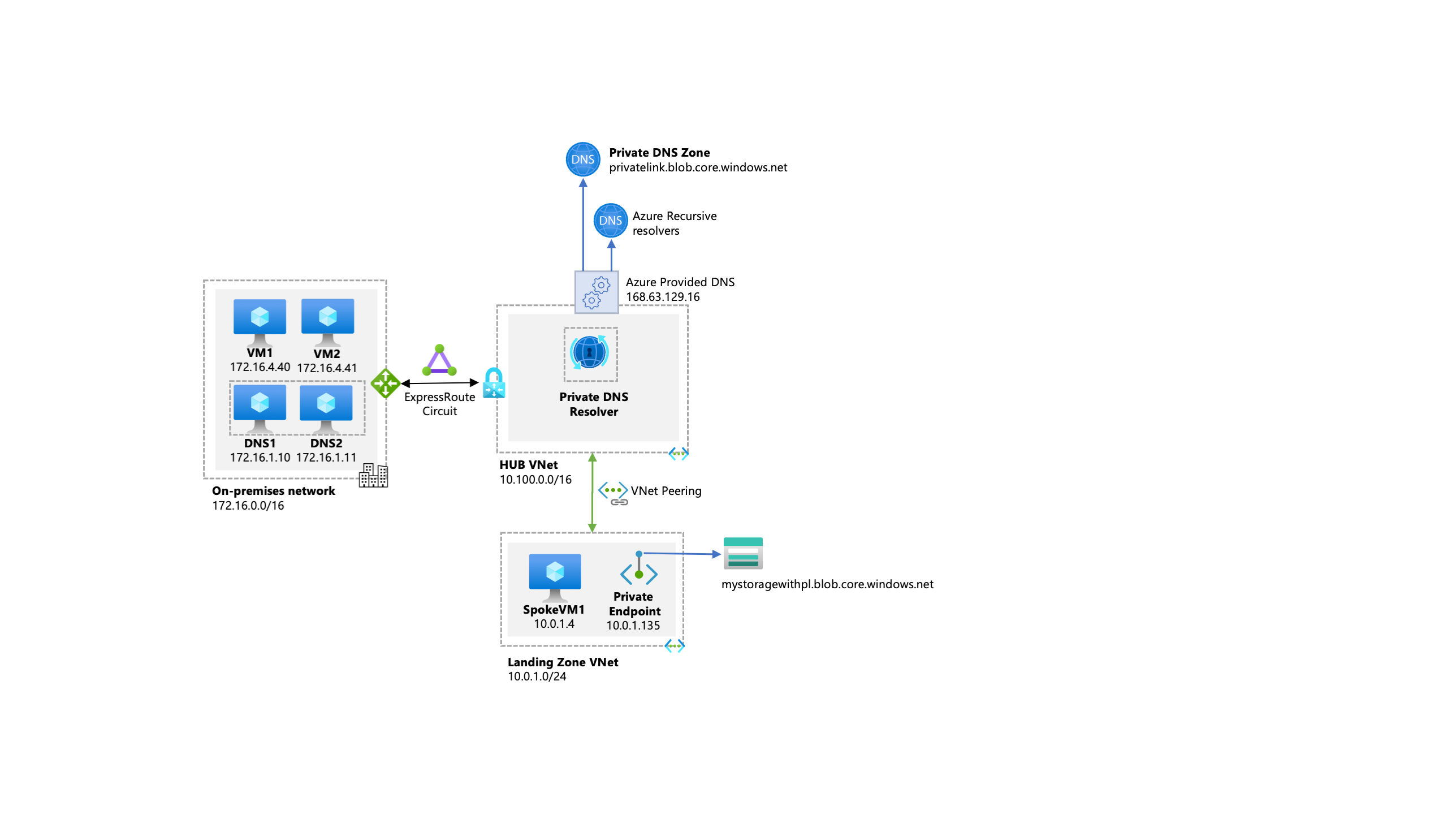
From the previous diagram, it's important to highlight that:
- On-premises DNS servers have conditional forwarders configured for each private endpoint public DNS zone, pointing to the Private DNS Resolver hosted in the hub VNet.
- The Private DNS Resolver hosted in the hub VNet use the Azure-provided DNS (168.63.129.16) as a forwarder.
- The hub VNet must be linked to the Private DNS zone names for Azure services (such as
privatelink.blob.core.windows.net, as shown in the diagram). - All Azure VNets use Private DNS Resolver hosted in the hub VNet
- As the Private DNS Resolver isn't authoritative for customer's corporate domains, as it's just a forwarder, (for example, Active Directory domain names), it should have outbound endpoint forwarders to the customer's corporate domains, pointing to the on-premises DNS Servers (172.16.1.10 and 172.16.1.11) or DNS servers deployed in Azure that are authoritative for such zones.
Note
You can deploy a DNS Private Resolver in your Hub Virtual Network alongside your ExpressRoute Gateway etc. However, you must ensure that resolution of public FQDNs is permitted and replies with a valid response via a DNS Forwarding Ruleset Rule to the targeted DNS server. As some Azure services rely upon rely upon the ability to resolve public DNS names to function. See more here
While the previous diagram depicts a single hub and spoke architecture, customers might need to extend their Azure footprint across multiple regions to address resiliency, proximity or data residency requirements, several scenarios have emerged where the same Private-Link-enabled PaaS instance must be accessed through multiple Private Endpoints (PE’s).
The following diagram shows a typical high-level architecture for enterprise environments with central DNS resolution deployed in the hub (one per region) where name resolution for Private Link resources is done via Azure Private DNS.
It is recommended to deploy multiple regional private endpoints associated to the PaaS instance, one in each region where clients exist, enable per-region Private Link and Private DNS Zones. When working with PaaS services with built-in DR capabilities (geo-redundant storage accounts, SQL DB failover groups, etc.), multiple region Private Endpoints are mandatory.
This scenario requires manual maintenance/updates of the Private Link DNS record set in every region as there is currently no automated lifecycle management for these.
For other use cases, a single global Private Endpoint can be deployed, making accessible to all clients by adding routing from the relevant regions to the single Private Endpoint in a single region.
To enable resolution, and therefore connectivity, from on premise networks to the privatelink private DNS zone and private endpoints, the appropriate DNS configuration (such as conditional forwarders) need to be provisioned in the DNS infrastructure.
There are two conditions that must be true for application teams to create any required Azure PaaS resources in their subscription:
- Central networking and/or central platform team must ensure that application teams can only deploy and access Azure PaaS services by way of private endpoints.
- Central networking and/or central platform teams must ensure that when they create private endpoints, they set up how to handle the corresponding records. Set up the corresponding records such that they're automatically created in the centralized private DNS zone that matches the service being created.
- DNS records must follow the lifecycle of the private endpoint, in that, it's automatically removed when the private endpoint is deleted.
Note
If FQDNs in network rules based on DNS resolution is needed to be used in Azure Firewall and Firewall policy (This capability allows you to filter outbound traffic with any TCP/UDP protocol -including NTP, SSH, RDP, and more-). You must enable Azure Firewall DNS Proxy to use FQDNs in your network rules, then those spoke VNets are forced to change their DNS setting from custom DNS server to Azure Firewall DNS Proxy. Changing the DNS settings of a spoke VNet requires reboot of all VMs inside that VNet.
The following sections describe how application teams enable these conditions by using Azure Policy. The example uses Azure Storage as the Azure service that application teams need to deploy. But the same principle applies to most Azure services that support Private Link.
Configuration required by the platform team
The platform team configuration requirements include creating the private DNS zones, setting up policy definitions, deploying policies, and setting up the policy assignments.
Create private DNS zones
Create private DNS zones in the central connectivity subscription for the supported Private Link services. For more information, see Azure Private Endpoint DNS configuration.
In this case, Storage account with blob is the example. It translates to creating a privatelink.blob.core.windows.net private DNS zone in the connectivity subscription.

Policy definitions
In addition to the private DNS zones, you also need to create a set of custom Azure Policy definitions. These definitions enforce the use of private endpoints and automate creating the DNS record in the DNS zone that you create:
Denypublic endpoint for PaaS services policy.This policy prevents users from creating Azure PaaS services with public endpoints and gives them an error message if they don't select the private endpoint when creating the resource.
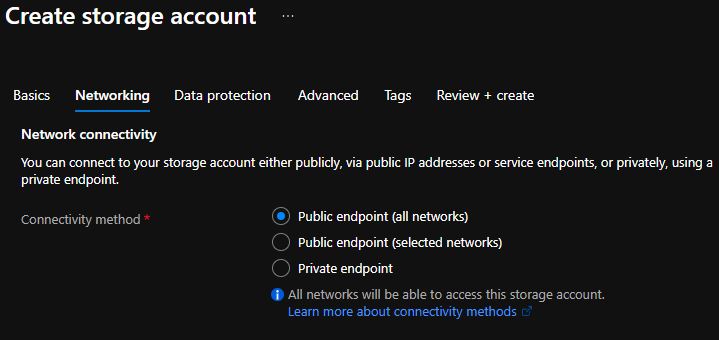

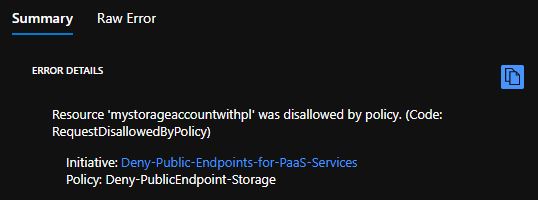
The exact policy rule might differ between PaaS services. For Azure Storage accounts, look at the networkAcls.defaultAction property that defines whether requests from public networks are allowed or not. In this case, set a condition to deny creating the Microsoft.Storage/storageAccounts resource type if the property networkAcls.defaultAction isn't
Deny. The following policy definition shows the behavior:{ "mode": "All", "policyRule": { "if": { "allOf": [ { "field": "type", "equals": "Microsoft.Storage/storageAccounts" }, { "field": "Microsoft.Storage/storageAccounts/networkAcls.defaultAction", "notEquals": "Deny" } ] }, "then": { "effect": "Deny" } } }Denythe ability to create a private DNS zone with theprivatelinkprefix policy.Use a centralized DNS architecture with a conditional forwarder and private DNS zones hosted in the subscriptions managed by the platform team. It's necessary to prevent the application teams owners from creating their own Private Link private DNS zones and linking services into their subscriptions.
Ensure that when your application team creates a private endpoint, the option to
Integrate with private DNS zoneis set toNoin the Azure portal.
If you select
Yes, Azure Policy prevents you from creating the private endpoint. In the policy definition, it denies the ability to create the Microsoft.Network/privateDnsZones resource type if the zone has theprivatelinkprefix. The following policy definition shows theprivatelinkprefix:{ "description": "This policy restricts creation of private DNS zones with the `privatelink` prefix", "displayName": "Deny-PrivateDNSZone-PrivateLink", "mode": "All", "parameters": null, "policyRule": { "if": { "allOf": [ { "field": "type", "equals": "Microsoft.Network/privateDnsZones" }, { "field": "name", "contains": "privatelink." } ] }, "then": { "effect": "Deny" } } }DeployIfNotExistspolicy to automatically create the required DNS record in the central private DNS zone.The following policy examples show two approaches for identifying which
privateDNSZoneGroupis created on a Private Endpoint.The first policy relies on the
groupIdwhile the second policy uses bothprivateLinkServiceIdandgroupID. Use the second policy whengroupIdwill clash (collide) with another resource.For example, the
groupIdSQL is used for both Cosmos DB and Synapse Analytics. If both resource types deploy and the first policy has been assigned to create theprivateDNSZoneGroupon the Private Endpoint entry, it's created and mapped to the incorrect Private DNS Zone, of either Cosmos DB or Synapse Analytics. It then might toggle between each of the zones due to the clashinggroupIdthat the first policy looks for in its policy rule.For a list of Private-link resources
groupId, see the subresources column in What is a private endpoint?.
Tip
Azure Policy built-in definitions are constantly being added, deleted, and updated. It's highly recommended to use built-in policies versus managing your own policies (where available). Use the AzPolicyAdvertizer to find existing built-in policies that have the following name of 'xxx ... to use private DNS zones'. In addition, Azure Landing Zones (ALZ) has a policy initiative, Configure Azure PaaS services to use private DNS zones, that contains built-in policies as well and periodically updated. If a built-in policy isn't available for your situation, consider creating an issue on the azure-policy feedback site Azure Governance · Community following the New built-in Policy Proposals process on the Azure Policy GitHub repo.
First DeployIfNotExists Policy - Matching on groupId only
This policy triggers if you create a private endpoint resource with a service-specific groupId. The groupId is the ID of the group obtained from the remote resource (service) that this private endpoint should connect to. It then triggers a deployment of a privateDNSZoneGroup within the private endpoint, which associates the private endpoint with the private DNS zone. In the example, the groupId for Azure Storage blobs is blob. For more information on the groupId for other Azure services, see Azure Private Endpoint DNS configuration, under the Subresource column. When the policy finds the groupId in the private endpoint, it deploys a privateDNSZoneGroup within the private endpoint, and links it to the private DNS zone resource ID that's specified as the parameter. In the example, the private DNS zone resource ID is:
/subscriptions/<subscription-id>/resourceGroups/<resourceGroupName>/providers/Microsoft.Network/privateDnsZones/privatelink.blob.core.windows.net
The following code sample shows the policy definition:
{
"mode": "Indexed",
"policyRule": {
"if": {
"allOf": [
{
"field": "type",
"equals": "Microsoft.Network/privateEndpoints"
},
{
"count": {
"field": "Microsoft.Network/privateEndpoints/privateLinkServiceConnections[*].groupIds[*]",
"where": {
"field": "Microsoft.Network/privateEndpoints/privateLinkServiceConnections[*].groupIds[*]",
"equals": "blob"
}
},
"greaterOrEquals": 1
}
]
},
"then": {
"effect": "deployIfNotExists",
"details": {
"type": "Microsoft.Network/privateEndpoints/privateDnsZoneGroups",
"roleDefinitionIds": [
"/providers/Microsoft.Authorization/roleDefinitions/4d97b98b-1d4f-4787-a291-c67834d212e7"
],
"deployment": {
"properties": {
"mode": "incremental",
"template": {
"$schema": "https://schema.management.azure.com/schemas/2019-04-01/deploymentTemplate.json#",
"contentVersion": "1.0.0.0",
"parameters": {
"privateDnsZoneId": {
"type": "string"
},
"privateEndpointName": {
"type": "string"
},
"location": {
"type": "string"
}
},
"resources": [
{
"name": "[concat(parameters('privateEndpointName'), '/deployedByPolicy')]",
"type": "Microsoft.Network/privateEndpoints/privateDnsZoneGroups",
"apiVersion": "2020-03-01",
"location": "[parameters('location')]",
"properties": {
"privateDnsZoneConfigs": [
{
"name": "storageBlob-privateDnsZone",
"properties": {
"privateDnsZoneId": "[parameters('privateDnsZoneId')]"
}
}
]
}
}
]
},
"parameters": {
"privateDnsZoneId": {
"value": "[parameters('privateDnsZoneId')]"
},
"privateEndpointName": {
"value": "[field('name')]"
},
"location": {
"value": "[field('location')]"
}
}
}
}
}
}
},
"parameters": {
"privateDnsZoneId": {
"type": "String",
"metadata": {
"displayName": "privateDnsZoneId",
"strongType": "Microsoft.Network/privateDnsZones"
}
}
}
}
Second DeployIfNotExists Policy - Matching on groupId & privateLinkServiceId
This policy triggers if you create a private endpoint resource with a service-specific groupId and privateLinkServiceId. The groupId is the ID of the group obtained from the remote resource (service) that this private endpoint should connect to. The privateLinkServiceId is the resource ID of the remote resource (service) this private endpoint should connect to. Then, trigger a deployment of a privateDNSZoneGroup within the private endpoint, which associates the private endpoint with the private DNS zone.
In the example, the groupId for Azure Cosmos DB (SQL) is SQL and the privateLinkServiceId must contain Microsoft.DocumentDb/databaseAccounts. For more information on the groupId and privateLinkServiceId for other Azure services, see Azure Private Endpoint DNS configuration, under the Subresource column. When the policy finds groupId and privateLinkServiceId in the private endpoint, it deploys a privateDNSZoneGroup within the private endpoint. And it's linked to the private DNS zone resource ID that's specified as the parameter. The following policy definition shows the private DNS zone resource ID:
/subscriptions/<subscription-id>/resourceGroups/<resourceGroupName>/providers/Microsoft.Network/privateDnsZones/privatelink.documents.azure.com
The following code sample shows the policy definition:
{
"mode": "Indexed",
"policyRule": {
"if": {
"allOf": [
{
"field": "type",
"equals": "Microsoft.Network/privateEndpoints"
},
{
"count": {
"field": "Microsoft.Network/privateEndpoints/privateLinkServiceConnections[*]",
"where": {
"allOf": [
{
"field": "Microsoft.Network/privateEndpoints/privateLinkServiceConnections[*].privateLinkServiceId",
"contains": "Microsoft.DocumentDb/databaseAccounts"
},
{
"field": "Microsoft.Network/privateEndpoints/privateLinkServiceConnections[*].groupIds[*]",
"equals": "[parameters('privateEndpointGroupId')]"
}
]
}
},
"greaterOrEquals": 1
}
]
},
"then": {
"effect": "[parameters('effect')]",
"details": {
"type": "Microsoft.Network/privateEndpoints/privateDnsZoneGroups",
"roleDefinitionIds": [
"/providers/Microsoft.Authorization/roleDefinitions/4d97b98b-1d4f-4787-a291-c67834d212e7"
],
"deployment": {
"properties": {
"mode": "incremental",
"template": {
"$schema": "https://schema.management.azure.com/schemas/2019-04-01/deploymentTemplate.json#",
"contentVersion": "1.0.0.0",
"parameters": {
"privateDnsZoneId": {
"type": "string"
},
"privateEndpointName": {
"type": "string"
},
"location": {
"type": "string"
}
},
"resources": [
{
"name": "[concat(parameters('privateEndpointName'), '/deployedByPolicy')]",
"type": "Microsoft.Network/privateEndpoints/privateDnsZoneGroups",
"apiVersion": "2020-03-01",
"location": "[parameters('location')]",
"properties": {
"privateDnsZoneConfigs": [
{
"name": "cosmosDB-privateDnsZone",
"properties": {
"privateDnsZoneId": "[parameters('privateDnsZoneId')]"
}
}
]
}
}
]
},
"parameters": {
"privateDnsZoneId": {
"value": "[parameters('privateDnsZoneId')]"
},
"privateEndpointName": {
"value": "[field('name')]"
},
"location": {
"value": "[field('location')]"
}
}
}
}
}
}
},
"parameters": {
"privateDnsZoneId": {
"type": "String",
"metadata": {
"displayName": "Private Dns Zone Id",
"description": "The private DNS zone to deploy in a new private DNS zone group and link to the private endpoint",
"strongType": "Microsoft.Network/privateDnsZones"
}
},
"privateEndpointGroupId": {
"type": "String",
"metadata": {
"displayName": "Private Endpoint Group Id",
"description": "A group Id for the private endpoint"
}
},
"effect": {
"type": "String",
"metadata": {
"displayName": "Effect",
"description": "Enable or disable the execution of the policy"
},
"allowedValues": [
"DeployIfNotExists",
"Disabled"
],
"defaultValue": "DeployIfNotExists"
}
}
}
Policy assignments
After policy definitions are deployed, assign the policies at the desired scope in your management group hierarchy. Ensure that the policy assignments target the Azure subscriptions the application teams use to deploy PaaS services with private endpoint access exclusively.
Important
In addition to assigning the roleDefinition defined in the policy, remember to assign the Private DNS Zone Contributor role role in the subscription and resource group where the private DNS zones are hosted to the managed identity created by the DeployIfNotExists policy assignment that will be responsible to create and manage the private endpoint DNS record in the private DNS zone. This is because the private endpoint is located in the application owner Azure subscription, while the private DNS zone is located in a different subscription (such as central connectivity subscription).
After the platform team finishes the configuration:
- The applications teams' Azure subscriptions are ready for the team to then create Azure PaaS services with private endpoint access exclusively.
- The team must ensure the DNS records for private endpoints are automatically registered (and removed once a private endpoint is deleted) from the corresponding private DNS zones.
Application owner experience
After the platform team deploys the platform infrastructure components (private DNS zones and policies), the application owner has the following experience when they try to deploy an Azure PaaS service into the Azure subscription. This experience is the same whether they do their activities through the Azure portal or other clients, such as PowerShell or CLI, since Azure policies govern their subscriptions.
Create a storage account through the Azure portal. In the Basics tab, choose the settings you want, provide a name for your storage account, and select Next.
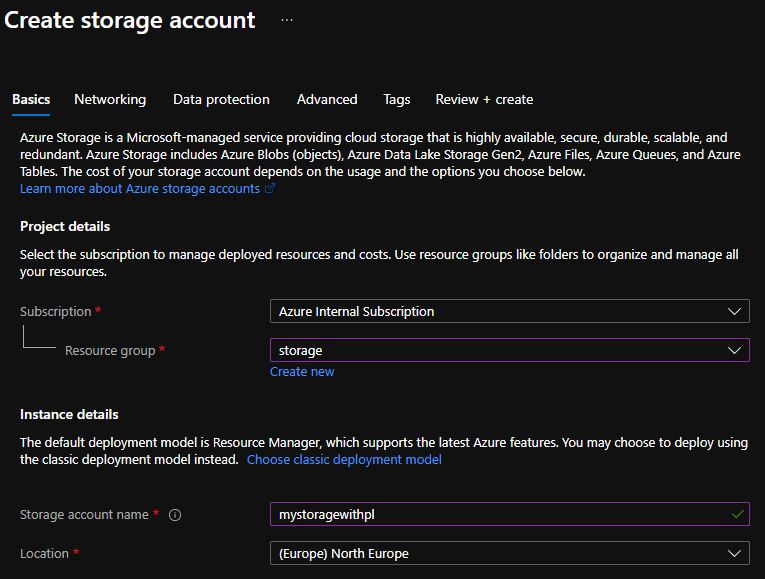
In the networking tab, select Private endpoint. If you select an option other than Private endpoint, the Azure portal won't allow you to create the storage account in the Review + create section of the deployment wizard. The policy prevents you from creating this service if the public endpoint is enabled.
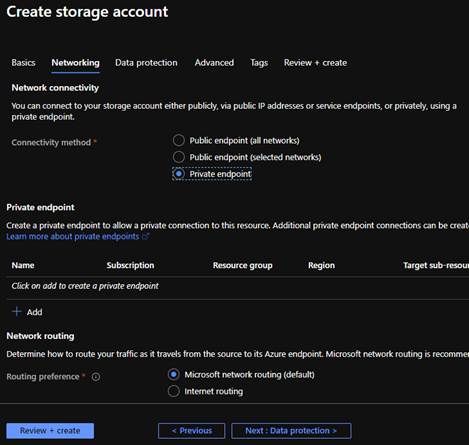
It's possible to create the private endpoint now or after you create the storage account. This example shows creating the private endpoint after the storage account is created. Select Review + create to complete the step.
After you create the storage account, make a private endpoint through the Azure portal.
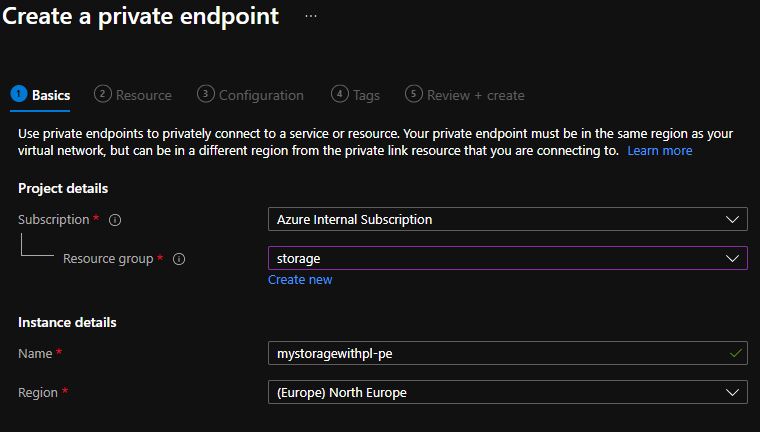
In the Resource section, locate the storage account you created in the previous step. Under target subresource, select Blob, and then select Next.
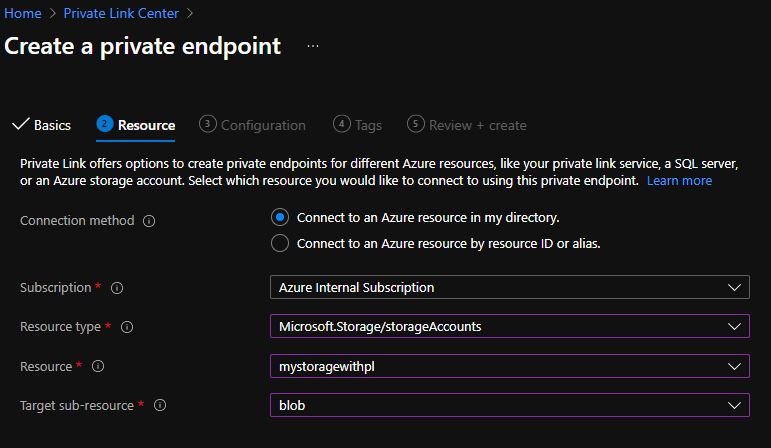
In the Configuration section, after selecting your VNet and subnet, be sure that Integrate with private DNS zone is set to No. Otherwise, the Azure portal prevents you from creating the private endpoint. Azure Policy won't allow you to create a private DNS zone with the
privatelinkprefix.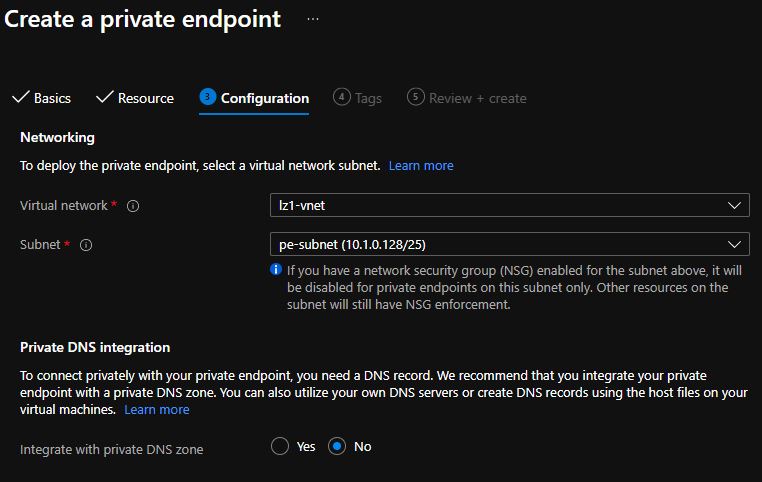
Select Review + create, and then select Create to deploy the private endpoint.
After a few minutes, the
DeployIfNotExistspolicy triggers. The subsequentdnsZoneGroupdeployment then adds the required DNS records for the private endpoint in the centrally managed DNS zone.After you create the private endpoint, select it, and review its FQDN and private IP:

Check the activity log for the resource group where the private endpoint was created. Or you can check the activity log of the private endpoint itself. You'll notice that after a few minutes, a
DeployIfNotExistpolicy action runs and that configures the DNS zone group on the private endpoint:
If the central networking team goes to the
privatelink.blob.core.windows.netprivate DNS zone, they'll confirm that the DNS record is there for the private endpoint you created, and both the name and IP address match the values within the private endpoint.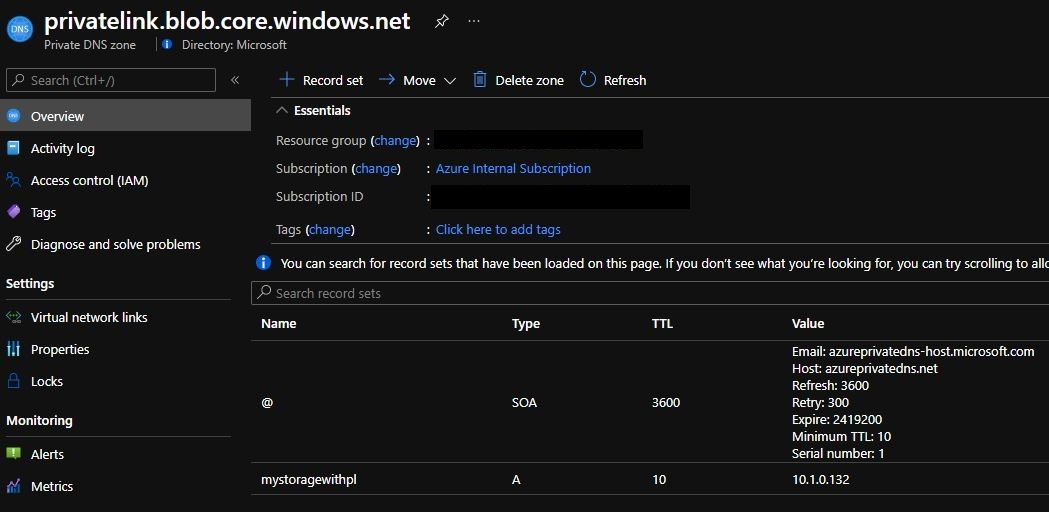
At this point, application teams can use the storage account through a private endpoint from any VNet in the hub and spoke network environment and from on-premises. The DNS record has been automatically recorded in the private DNS zone.
If an application owner deletes the private endpoint, the corresponding records in the private DNS zone are automatically removed.
Next steps
Review DNS for on-premises and Azure resources. Review Plan for virtual machine remote access.
Important
This article outlines DNS and Private link integration at scale using DINE (DeployIfNotExists) policies assigned to the Management Group. Which means there is no need to handle the DNS integration in code when creating Private Endpoints with this approach, as it is handled by the policies. It is also unlikely that the application teams have RBAC access to the centralized Private DNS Zones also.
Below are helpful links to review when creating Private Endpoint with Bicep and HashiCorp Terraform.
For Private Endpoint creation with Infrastructure-as-Code:
Create a private endpoint using HashiCorp Terraform azurerm_private_endpoint in Terrafrom Registry.
You can still create private endpoints in your Infrastructure-as-Code tooling however, if using the DINE policy approach as outlined in this article you should leave the DNS integration side out of your code and let the DINE policies that have the required RBAC to the Private DNS Zones handle this instead.
